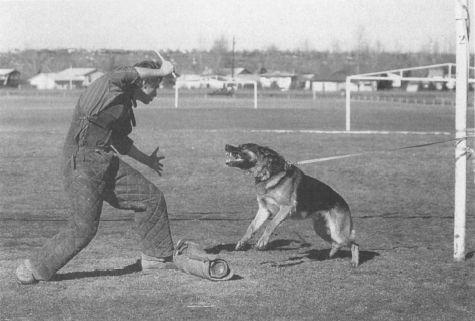CANINE AGGRESSION
The basic requirement of Schutzhund protection is the bite itself–the dog’s grip upon the sleeve. The power and quality of the bite are important not only from the standpoint of getting the job done (that is, stopping and disabling an aggressor). They are also important because how the dog bites provides an index to its quality as a working dog and as a prospect for breeding.
The ideal bite is what we call full, so that the dog grips the sleeve with its entire jaw, including the molar region. The dog need not fight this way in order to fight a human effectively. But working dog trainers have found over many years that dogs that bite full are normally the best and the bravest animals.
What makes the difference between the dog that bites full and the dog that does not is, to a great extent, their differing degrees of courage. But it is also a fact that the two animals are motivated to bite for different reasons, by different types of behavior. Their characters are different.
The dog that bites full displays at least a certain degree of prey drive. It pursues and bites the decoy for the same reason that it would chase and bite a rabbit. It is “hunting.” The dog in prey mood is unafraid. It bites quietly, its eyes are tranquil and its expression, although intensely keen, is neutral. This dog does not snarl or grimace or flinch as it bites. It enjoys itself and, most important, it will pursue. For the opportunity to bite it will run hundreds of yards or even search for extended periods of time.
The animal that bites with only half of its mouth, or with just its canine teeth, shows a different kind of behavior, a different urge that we call defense drive. This dog bites not because it is fun for it, but because it feels it must. It is stressed. It feels endangered, and to at least some extent afraid, and it bites primarily to defend itself. It is therefore much less keen to pursue a person or search in order to find him and engage him in combat. In addition to biting with just the front of its mouth, the defense dog also tends to chew, or nervously shift his grip, especially when under pressure. This dog bites violently and with malevolence. The defense dog is also noisy while it bites, growling and snarling, and it often bristles, erecting the hair on the withers, back and rump.
Almost every animal has the capacity (to some extent) to express both prey‑ and defense‑motivated aggression. Because each type of behavior has its advantages, during agitation we make use of them both.
Prey brings with it eagerness and pleasure in biting. But a “pure” prey dog lacks intensity. In addition, it is also woefully unprepared to bite in a real‑life “street” situation in which it is called upon to protect itself and its owner from harm. Remember , a Schutzhund dog should also be a civil protection dog. During agitation, the prey dog is taught to regard the protective sleeve that the agitator wears as prey, like a rabbit or some other animal that the dog would naturally chase down and bite. It will happily bite anyone that wears the sleeve, even its handler. Consequently, when faced with a person who means to do it or its owner harm, and who wears no sleeve and does not follow the rules of agitation, it is very much at a loss.
The defense dog, on the other hand, is what we call sharp –it is always ready to fight, and fight in earnest, in threatening or disorienting circumstances. It is “strong‑civil,” meaning that it is less interested in the sleeve than the prey dog and more eager to close with the agitator himself. Defense brings with it intensity and violence, and the power to fight in a deadly situation.
However, defense also brings with it stress. The fact that the animal behaves defensively implies that it feels endangered, that fear is at the root of its actions. Consequently, the pure defense dog leaves many things to be desired. For example, it does not bite with a full mouth on the sleeve, and it is frequently too overstimulated during agitation to learn well.
In training, we strive to make the protection dog a balanced animal that expresses both prey‑ and defense‑motivated behavior. However, although with intelligent work we can change the dog’s basic orientation to some extent, its basic prey‑versus‑defense characteristics are mainly a product of genetics. The animal comes to us primarily prey‑oriented or primarily defense‑oriented. Therefore, as trainers and sportspeople, it is important to choose the type of dog with advantages and disadvantages that suit us best.

Prey behavior. As the helper reaches to steal the grounded sleeve–the dog’s prey–the animal orients at the sleeve itself rather than at the person. The dog’s facial expression is neutral, reflecting only keenness and strength of effort to reach the prey.

Defense behavior. Now the helper attacks the dog. The animal focuses on the attacker rather than the sleeve, and the change in the dog’s expression is dramatic.

In prey mood the dog does not threaten, seeking only to reach the prey and bite.

In defense mood, the dog threatens.
The authors prefer an animal that is fundamentally a prey dog. It bites for fun, day after day, clearheaded and happy, but there is a deadly serious edge of defense to it that lends it intensity. Prey will give it pleasure in biting and durability over years of competition and training, while defense will give it the raw power and violence we can call on in time of need.
Дата добавления: 2015-05-08; просмотров: 1070;
